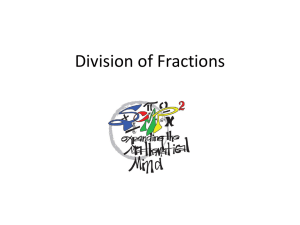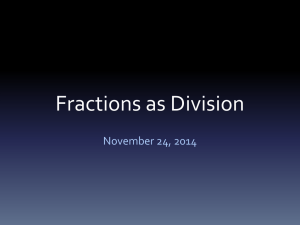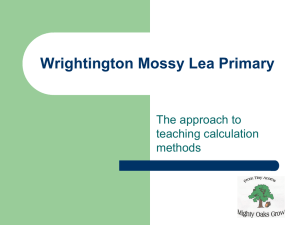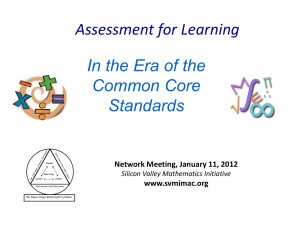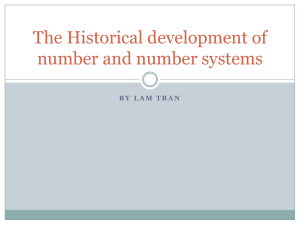Word
advertisement
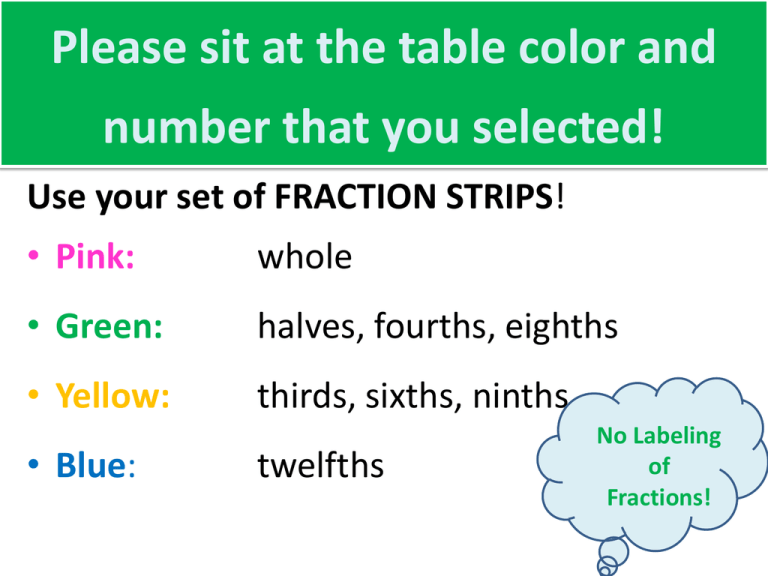
Please sit at the table color and number that you selected! Use your set of FRACTION STRIPS! • Pink: whole • Green: halves, fourths, eighths • Yellow: thirds, sixths, ninths • Blue: twelfths No Labeling of Fractions! Fractions… Putting the pieces together Academic Coaches – Math Meeting March 1, 2013 Beth Schefelker Bridget Schock Connie Laughlin Hank Kepner Kevin McLeod From Fraction Strips to the Number Line • Use the fraction strips to make a number line from 0 to 1, so that the whole is the same length as the whole fraction strip. • Line up the fraction strips under the number line, one at a time, and mark the equal-sized parts. • Label the marks with fraction symbols. Don’t forget to also label fractions such as 0/4 and 4/4. What observations do you want students to make about fraction relationships to help them decide if two fractions are equivalent? Transitioning from Fractions Strips to a Number Line Learning Intentions & Success Criteria Learning Intention We are learning to understand the links between equivalence of fractions and operations with fractions. Success Criteria We will be successful when we can create and explain standards progressions that show the interconnectedness of fraction standards. What mathematical foundations need to be laid in order for students to be successful with this standard? 5.NF. Use equivalent fractions as a strategy to add and subtract fractions. 2. Solve word problems involving addition and subtraction of fractions referring to the same whole, including cases of unlike denominators, e.g., by using visual fraction models or equations to represent the problem. Use benchmark fractions and number sense of fractions to estimate mentally and assess the reasonableness of answers. Identifying Coherence in NF Create a flowchart of standards and connections Green: Equivalence of Fractions for grades 3-5 Orange: Addition and Subtraction of Fractions for grades 3 - 5 Reading the Progressions Document Equivalence Read pages 3-6 Stop at… Adding/Subtracting Fractions Adding/Subtracting Read pages 6 – 7 Stop at… Multiplication of Fractions Read page 10 Read page 10 Identifying Coherence in NF Revisit your flowchart of standards and connections, make additions Green: Equivalence of Fractions for grades 3-5 Orange: Addition and Subtraction of Fractions for grades 3 - 5 Putting the Pieces Together Share your flowchart of standards and connections with a group with the same table number. Identify connections or relations across the charts. Meanings, Properties, and Uses How does Zimba’s message validate the work we’ve been doing? http://www.youtube.com/watch?v=HMMe8_4s9KE What mathematical foundations need to be laid in order for students to be successful with this standard? 5.NF. Use equivalent fractions as a strategy to add and subtract fractions. 2. Solve word problems involving addition and subtraction of fractions referring to the same whole, including cases of unlike denominators, e.g., by using visual fraction models or equations to represent the problem. Use benchmark fractions and number sense of fractions to estimate mentally and assess the reasonableness of answers. Role As A Coach As a math coach… How are you going to support the development of these ideas within and across grade levels? How will we ensure that your teachers understand the role they play in developing and building the coherence of these ideas? Learning Intentions & Success Criteria Learning Intention We are learning to understand the links between equivalence of fractions and operations with fractions. Success Criteria We will be successful when we can create and explain standards progressions that show the interconnectedness of fraction standards. Reflection What might be some strategies to ensure that your teachers understand the role they play in developing and building the coherence of these ideas? What new insights did you gain while working with your peers? Professional Practice Engage in a coaching conversation with your teachers around these ideas. Be prepared to share these experiences with your peers on April 12th ACM meeting.



